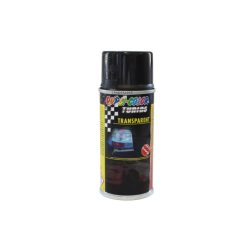Our Paints selection covers aerosol solutions and accessories for light refinishing and detailing. Expect clean application, solid coverage and reliable adhesion on metal, plastics or pre-coated parts. Check heat resistance, surface prep and re-coat windows before use. Optical products such as light-tinting spray are clearly indicated—always comply with local roadworthiness rules.
Brief summary & key benefits
The Paints category focuses on quick, neat and safe refinishing for home garages and workshops. Aerosols deliver fine atomisation, even coverage and easy storage. Typical use cases include stone-chip touch-ups, plastic trim unification, wheel accessories refresh and optical effects such as light tinting. Our benefits: clear instructions, curated colours/effects and substrates-matched primers and clearcoats. Note: poor surface prep leads to adhesion issues—follow the steps carefully.
Technical Basics
Automotive aerosols commonly use acrylic, alkyd or nitrocellulose binders; special lines may employ silicone or heat-resistant resins. Dry film thickness per coat is typically 10–25 µm, hence multiple thin coats are recommended. Substrates include galvanised steel, aluminium, ABS/PP plastics and existing clear coat. Compatibility depends on primer chemistry and solvent system; when in doubt, perform an adhesion test.
Preparation: degrease (isopropyl alcohol or silicone remover), remove corrosion, then sand with P320–P600 to promote mechanical key. Use a plastic primer on polymers and a zinc/phosphating primer on bare metals. Application environment: ~18–25 °C, low humidity, dust-free. Shake the can for 2–3 minutes and spray from 20–30 cm using a cross-coat pattern.
Drying & re-coat: dust-free in 10–20 min, touch-dry in 30–60 min, full cure in 24–48 h at 20 °C. Observe the specified re-coat window to avoid lifting, orange peel or solvent attack. Heat-resistant coatings may require staged bake/heat cycling to reach final properties.
Optical products (e.g., light-tint sprays) demand attention to light transmission and film thickness. Excessive darkening can reduce visibility and may breach regulations—apply sparingly and check local rules.
Selection Criteria
1) Substrate: choose systems tailored to bare metal, plastics or previously coated panels. Plastics need a dedicated adhesion promoter; porous fillers may benefit from a high-build primer.
2) Heat & chemical resistance: under-bonnet or brake-adjacent parts require higher temperature ratings. Exterior parts call for UV stability and surface hardness against detergents.
3) Colour & gloss: pick RAL/OE shades and the desired finish—matt, satin or high-gloss. For durability, protect colour coats with a clear.
4) Nozzle & atomisation: adjustable fan patterns help achieve uniform edges, especially on curves.
5) Compliance: darkening lighting units or reflectors may be restricted for road use; verify regulations and apply within limits.
Installation & Maintenance
Masking: use quality tape and film for crisp lines. To prevent edge lifting, peel the tape before full cure. Maintain a dust-free area and correct spray distance.
Layering: apply several light coats with brief flash-off times. Heavy wet coats cause runs; if defects occur, allow to dry, then correct with fine sanding before re-spraying.
Aftercare: be gentle during the first week—avoid close-range pressure washing and harsh solvents. For chip-prone areas, add a protective clear or film.
Safety: wear gloves and a mask for solvent-borne products, ensure adequate ventilation and keep away from ignition sources. Store out of reach of children.
FAQ
Q: Do I need a primer before spot repairs?
A: Yes on bare metal or plastics; on intact clear coat a fine sand and degrease may suffice, though an adhesion promoter improves durability.
Q: When should I apply a clear coat?
A: Always on exterior or high-wear parts—improves UV, chemical and scratch resistance and deepens colour.
Q: Why do I get orange peel?
A: Too far spray distance, low temperature or fast solvent flash-off. Warm the panel, move closer and use thinner coats.
Q: Is light tinting legal on the road?
A: Only within the permitted limits. Excessive darkening reduces light output and may fail inspection.
Q: What’s the typical full cure time?
A: Around 24–48 hours at 20 °C; heat-resistant paints may need staged heating to reach final properties.


